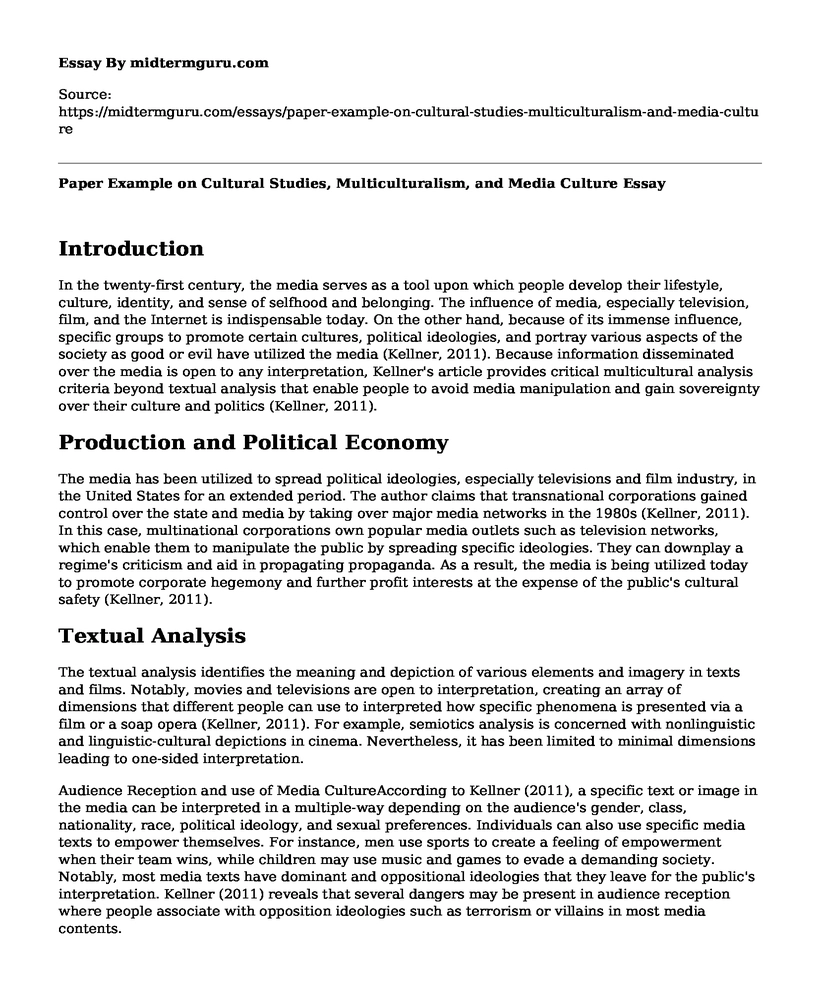Introduction
In the twenty-first century, the media serves as a tool upon which people develop their lifestyle, culture, identity, and sense of selfhood and belonging. The influence of media, especially television, film, and the Internet is indispensable today. On the other hand, because of its immense influence, specific groups to promote certain cultures, political ideologies, and portray various aspects of the society as good or evil have utilized the media (Kellner, 2011). Because information disseminated over the media is open to any interpretation, Kellner's article provides critical multicultural analysis criteria beyond textual analysis that enable people to avoid media manipulation and gain sovereignty over their culture and politics (Kellner, 2011).
Production and Political Economy
The media has been utilized to spread political ideologies, especially televisions and film industry, in the United States for an extended period. The author claims that transnational corporations gained control over the state and media by taking over major media networks in the 1980s (Kellner, 2011). In this case, multinational corporations own popular media outlets such as television networks, which enable them to manipulate the public by spreading specific ideologies. They can downplay a regime's criticism and aid in propagating propaganda. As a result, the media is being utilized today to promote corporate hegemony and further profit interests at the expense of the public's cultural safety (Kellner, 2011).
Textual Analysis
The textual analysis identifies the meaning and depiction of various elements and imagery in texts and films. Notably, movies and televisions are open to interpretation, creating an array of dimensions that different people can use to interpreted how specific phenomena is presented via a film or a soap opera (Kellner, 2011). For example, semiotics analysis is concerned with nonlinguistic and linguistic-cultural depictions in cinema. Nevertheless, it has been limited to minimal dimensions leading to one-sided interpretation.
Audience Reception and use of Media CultureAccording to Kellner (2011), a specific text or image in the media can be interpreted in a multiple-way depending on the audience's gender, class, nationality, race, political ideology, and sexual preferences. Individuals can also use specific media texts to empower themselves. For instance, men use sports to create a feeling of empowerment when their team wins, while children may use music and games to evade a demanding society. Notably, most media texts have dominant and oppositional ideologies that they leave for the public's interpretation. Kellner (2011) reveals that several dangers may be present in audience reception where people associate with opposition ideologies such as terrorism or villains in most media contents.
The commentary claims that to eliminate one-sided audience reception and textual analysis of media information, cultural studies should be multi-perspective. In this case, the reviews will encompass cultural analysis from a political, textual, and audience reception perspective as opposed to one of the elements (Kellner, 2011). The new study approach will also consider race, gender ethnicity, sexual orientation, and class in media analysis alongside the media's impact on culture.
Response
Kellner's article is informative and successful in presenting all dimensions upon which the media influence modern-day culture. The report reveals how the media has been utilized to prey on the audiences' one-sided interpretation of texts to spread propaganda and control a specific culture. However, I agree with the author that new critical, multicultural, and multi-perspectival cultural studies are essential in minimizing manipulation and negative audience reception. I believe that if people interpret a media text from a comprehensive perspective, they can identify various meanings and choose appropriate ones. Additionally, the situation will enhance cultural sovereignty and allow people to create a better society.
Reference
Kellner, D. (2011). Cultural studies, multiculturalism, and media culture. Gender, Race, and Class in Media: A Critical Reader, 3, 7-18.
Cite this page
Paper Example on Cultural Studies, Multiculturalism, and Media Culture. (2022, Sep 12). Retrieved from https://midtermguru.com/essays/paper-example-on-cultural-studies-multiculturalism-and-media-culture
If you are the original author of this essay and no longer wish to have it published on the midtermguru.com website, please click below to request its removal:
- The New Yorker Article: Two Men Arrive in a Village by Zadie Smith
- Essay on Writing Techniques: Using Location to to Convince Readers
- Essay on Theatre Classification
- Analysis of Magazine Covers - Paper Example
- The Use of Sound in the Film "Applause" (1929) by Rouben Mamoulian - Essay Sample
- A Death in St. Augustine - Critical Essay
- James Franco: From Palo Alto to Hollywood Stardom - Essay Sample







